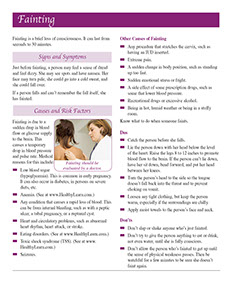CONDITIONS
SYMPTOM CHECKER
Male
Female
Child
Arm, Hand & Shoulder Concerns
Legs & Feet Concerns
Dental & Mouth Concerns
Ear & Nose
Eye Conditions
Head Conditions
Arm, Hand & Shoulder Concerns
Legs & Feet Concerns
Front
Back
Arm, Hand & Shoulder Concerns
Dental & Mouth Concerns
Ear & Nose
Eye Conditions
Head Conditions
Arm, Hand & Shoulder Concerns
Dental & Mouth Concerns
Ear & Nose
Eye Conditions
Head Conditions
Front
Back
Arm, Hand & Shoulder Concerns
Neck Links
Head & Neck Concerns
Arm, Hand & Shoulder Concerns
Neck Links
Head & Neck Concerns
Front
Back
Online Clinic
Wise Healthcare
Fainting
Print on Demand
RELATED ARTICLES
Fainting is a brief loss of consciousness. It can last from seconds to 30 minutes.
Signs & Symptoms
Causes
Fainting is due to a sudden drop in blood flow or glucose supply to the brain. This causes a temporary drop in blood pressure and pulse rate. Medical reasons for this include:
• Low blood sugar (hypoglycemia). This is common in early pregnancy. It can also occur in diabetes, in persons on severe diets, etc.
• Anemia.
• Any condition that causes a rapid loss of blood. This can be from internal bleeding, such as with a peptic ulcer, a tubal pregnancy, or a ruptured cyst.
• Heart and circulatory problems, such as abnormal heart rhythm, heart attack, or stroke.
• Eating disorders.
• Toxic shock syndrome (TSS).
• Seizures.
Other Causes of Fainting
• Any procedure that stretches the cervix, such as having an IUD inserted.
• Extreme pain.
• A sudden change in body position, such as standing up too fast.
• Sudden emotional stress or fright.
• A side effect of some prescription drugs, such as some that lower blood pressure.
• Recreational drugs or excessive alcohol.
• Being in hot, humid weather or being in a stuffy room.
Know what to do when someone faints.
Dos
• Catch the person before she falls.
• Lie the person down with her head below the level of the heart. Raise the legs 8 to 12 inches to promote blood flow to the brain. If the person can’t lie down, have her sit down, bend forward, and put her head between her knees.
• Turn the person’s head to the side so the tongue doesn’t fall back into the throat and to prevent choking on vomit.
• Loosen any tight clothing, but keep the person warm, especially if the surroundings are chilly.
• Apply moist towels to the person’s face and neck.
Don’ts
• Don’t slap or shake anyone who’s just fainted.
• Don’t try to give the person anything to eat or drink, not even water, until she is fully conscious.
• Don’t allow the person who’s fainted to get up until the sense of physical weakness passes. Then be watchful for a few minutes to be sure she doesn’t faint again.
Questions to Ask
Question 1
With fainting, are any “Signs & Symptoms–For a Heart Attack” present?
Get medical care without delay. If symptoms are life threatening go to the ER or call 9-1-1. Don’t call 9-1-1 or use the ER if symptoms do not threaten life. Ask your doctor ahead of time where you should go for a problem that needs prompt care, but not emergency care.
Call 911
Question 2
With fainting, do stroke signs occur?
• Sudden numbness or weakness of the face, arm or leg, especially on one side of the body.
• Sudden trouble seeing in one or both eyes.
• Sudden trouble walking, dizziness, loss of balance or coordination.
• Sudden, severe headache.
Get medical care without delay. If symptoms are life threatening go to the ER or call 9-1-1. Don’t call 9-1-1 or use the ER if symptoms do not threaten life. Ask your doctor ahead of time where you should go for a problem that needs prompt care, but not emergency care.
Call 911
Question 3
Is the person not breathing or did fainting occur after a head injury?
Get medical care without delay. If symptoms are life threatening go to the ER or call 9-1-1. Don’t call 9-1-1 or use the ER if symptoms do not threaten life. Ask your doctor ahead of time where you should go for a problem that needs prompt care, but not emergency care.
Question 4
With fainting, do you have severe pain in the pelvis or abdomen, black stools or blood in the stools or urine?
You should be seen by your doctor for medical advice. Contact your doctor or health care provider to find out how soon you should be seen.
Question 5
Have you fainted more than once?
You should be seen by your doctor for medical advice. Contact your doctor or health care provider to find out how soon you should be seen.
Question 6
Are you taking high blood pressure drugs or have you taken a new or increased dose of a prescribed drug?
Call your doctor or health care provider and state the problem. He or she can decide what you should do.
Use Self-Care:
You can probably take care of the problem yourself if you answered NO to all the questions. Use the “Self-Care” measures that are listed. Call your doctor if you don’t feel better soon, though. You may have some other problem.
Self-Care
• When you feel faint, lie down and elevate both legs. Or, sit down, bend forward and put your head between your knees.
• Get up slowly from bed or from a sitting position.
• Follow your doctor’s advice to treat any condition which may lead to fainting. Take prescribed medicines, but tell your doctor about any side effects, so he or she can monitor your condition.
• Don’t wear tight clothing around your neck.
• Avoid turning your head suddenly.
• Stay out of stuffy rooms and hot, humid places. If you can’t, use a fan.
• If you have fainting spells often, avoid activities that can put lives in danger, such as driving a car.
• Drink a lot of fluids, but drink alcoholic ones in moderation, if at all. Eat small, frequent meals.
When Pregnant
• Get out of bed slowly.
• Keep crackers at your bedside and eat a few before getting out of bed.
• Eat small, frequent meals instead of a few large ones. With each meal, have a good source of protein, such as lean meat, low-fat cheese, milk, etc. Avoid sweets. Don’t skip meals or go for a long time without eating. Drink plenty of fluids.
• Don’t sit for long periods of time. Elevate your legs when you sit.
• When you stand, as in a line, move your legs to pump blood up to your heart.
• Take vitamin and mineral supplements, as your doctor prescribes.
• Don’t lay on your back during the 2nd and 3rd trimesters of your pregnancy. Lie on your left side. When you can’t, lie on your right side.
This website is not meant to substitute for expert medical advice or treatment. Follow your doctor’s or health care provider’s advice if it differs from what is given in this guide.
The American Institute for Preventive Medicine (AIPM) is not responsible for the availability or content of external sites, nor does AIPM endorse them. Also, it is the responsibility of the user to examine the copyright and licensing restrictions of external pages and to secure all necessary permission.
The content on this website is proprietary. You may not modify, copy, reproduce, republish, upload, post, transmit, or distribute, in any manner, the material on the website without the written permission of AIPM.
2021 © American Institute for Preventive Medicine - All Rights Reserved. Disclaimer | www.HealthyLife.com
















































